What is a Spread (Shallow Cut) Diamond? Is It Good or Bad?
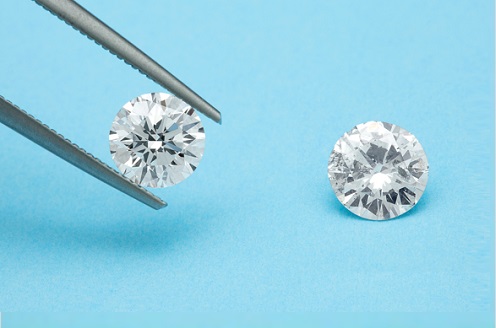
Bigger spread translates to larger looking diamonds.
If you are like most people, you probably want the biggest possible diamond when buying an engagement ring. However, when diamonds get bigger in carat size, they become exponentially more expensive.
So, is there a way you can get a bigger looking diamond without paying more for the additional carats? Well, there is. In the industry, these are called spread diamonds and are marketed by jewelers to give you “more bang for your buck”.
In this write up, you will find out what a spread diamond is and whether they are good or bad purchases. Let’s dive in…
What is Diamond Spread?
To put simply, spread determines how large a diamond appears to be for a given carat weight. For example, a 1ct round diamond with better spread will look bigger than a 1ct round diamond with a smaller spread.
Technically speaking, a diamond’s spread is affected by a confluence of factors like its diameter, depth, table size and girdle thickness. But the easiest way to think about spready diamonds is that they have a shallow cut.
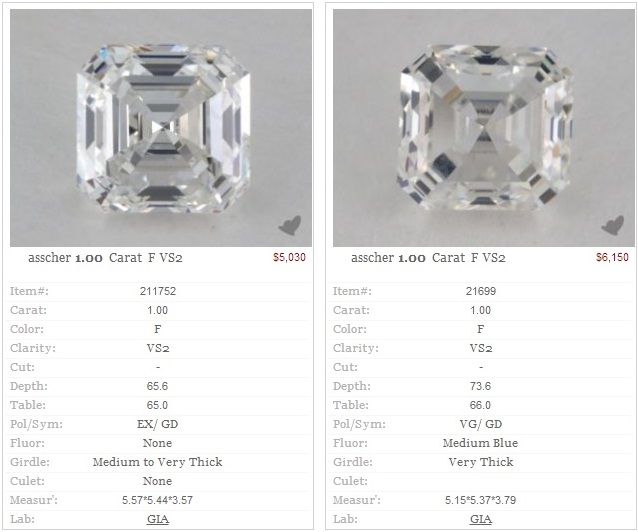
In the example above, both Asscher cuts are 1 carat in weight. Yet, the one on the left appears bigger to the eye because of its larger face-up measurements. As a result of the shallower depth, it has a better spread than the one on the right.
Is Diamond Spread Good or Bad?
Ideally speaking, you want to buy a diamond that has the right amount of spread so that its performance is not compromised. One of the best ways to make estimations is to use the depth percentage of the diamond as a rough reference.
You see, depth percentage has an inverse relationship to spread. A smaller depth percentage usually means that the weight of the diamond is distributed across its diameter. This results in a wider and bigger looking diamond.
For “ideal” depth proportions of the various shapes, you may want to refer to the proportion tables found at the respective sections of Beyond4cs.com. If you want to better assess a diamond’s spread, factors that make up the total depth percentage like light performance, girdle thickness, crown heights and pavilion heights should be taken into account.
What Are the Problems With Shallow Cut Diamonds?
You might think that maximizing spread by buying a shallow cut diamond would be the smartest way to buy a diamond. After all, you will get a bigger looking gemstone for a smaller carat weight.
While diamonds with a high spread have the advantages of appearing bigger, they will also lose their sparkle and brilliance as a trade-off. Let’s take a look at another 2 examples of round brilliant cut diamonds…
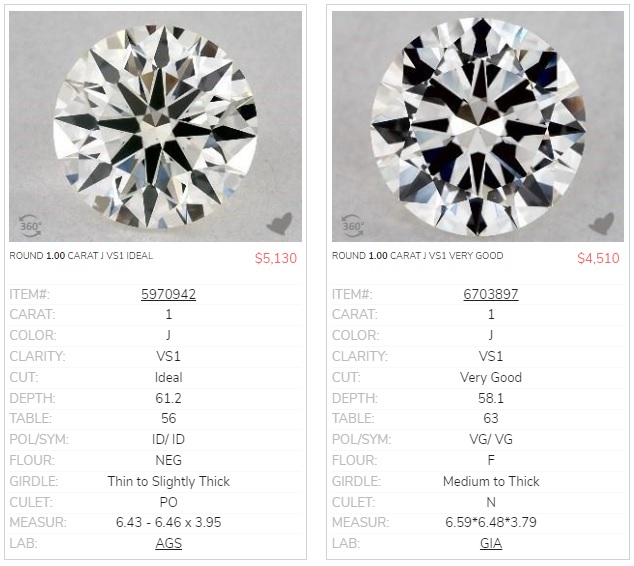
Even though the diamond on the right has a better spread, it is a horrendous looking diamond because of its shallow cut and poor proportions. The one on the left has top of the line sparkle and brilliance which makes it a significantly better buy!
Cut Details Matter When It Comes to Spread
The trickier aspect which influences how weight is distributed across the diamond is girdle thickness.
For round cut diamonds, a consumer would have an easier time as both GIA and AGS would take into account issues related to spread when grading a diamond’s cut quality. But when it comes to fancy cut diamonds like the emerald cut or pear cut, there is very limited information provided in a grading report.
Without a Sarin report or Helium scan, it is almost impossible to gauge how much weight is taken up by the girdle thickness. For example, even if you see a very thin to very thick girdle description in a lab report, it tells you nothing concrete about the details.
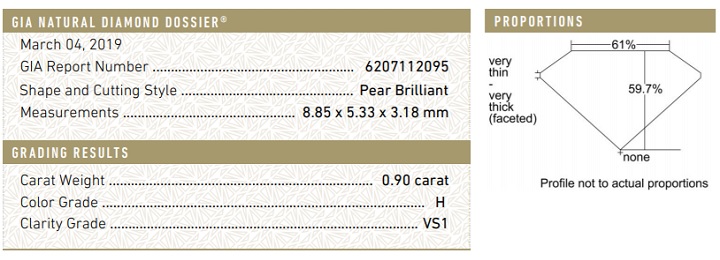
Is the girdle only 2% thin and 98% thick?? Or is the girdle very thin at 90% of the diamond’s diameter and 10% very thick at certain portions? Obviously, the diamond will have a better spread in the latter scenario.
And in case you are wondering, the diamond above actually has a pretty uniform”very thick” girdle thickness. How do I know? Well, I actually reviewed the video listing at James Allen to see how it looks like in real life.
Likewise, weight retention methods like the use of pavilion bulges in step cut diamonds can make a diamond look smaller. In these cases, even though the diamond might exhibit a low depth (e.g. 57.0%), it doesn’t necessarily translate into better spread because its weight is now retained at the pavilions!
Two Things You Should Keep In Mind
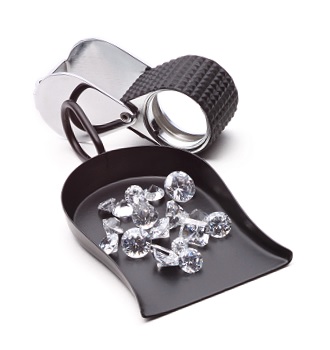
#1: A depth percentage value between 58% and 62.6% is required for round brilliants to exhibit good brilliance. Note that these values are not minimum or maximum values. Based on observations, when round diamonds are cut to depths lower than 58% or over 62.6%, it usually leads to severe problems in optics.
If we go beyond both extreme ends of the spectrum, the beauty of the stone could be severely undermined due to the occurrences of fish-eye effects or dark nail head appearances.
#2: Deciding whether the spread of a certain stone fits your needs based on total depth percentage can be tricky. There are a number of practices (e.g., changing girdle thickness with painting or digging) that do affect depth percentage while not affecting spread.
A better way to consider spread is to make use of carat size charts to extrapolate the dimensions of a particular carat weight for its respective shape. You should also rely on tangible data like videos and ASET/Idealscope images to help you make educated decisions.
Should You Buy Spread Diamonds?
Spready diamonds are still “desirable” to some degree since size does matter to consumers. However, I personally treat them like cheaters amongst diamonds. Bear this in mind: truly well cut diamonds seldom appear larger than what they really are due to the physics of how light interacts with the facets.
On a closing note, diamonds are like the queens of jewelry. Imagine the Queen of Great Britain bragging in a swashbuckling manner like “Ha, I am the queen and you are not!”.
To put in simple words, spread diamonds are the braggarts among gemstones. They appear to look big on first glance but when examined closely, they lack sparkle and character.
Related Articles
Leave A Comment

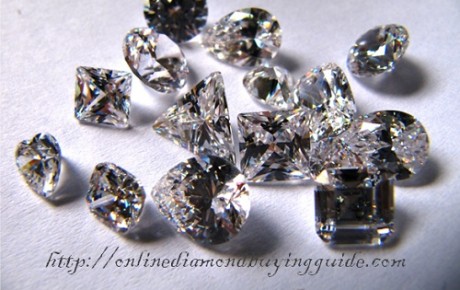
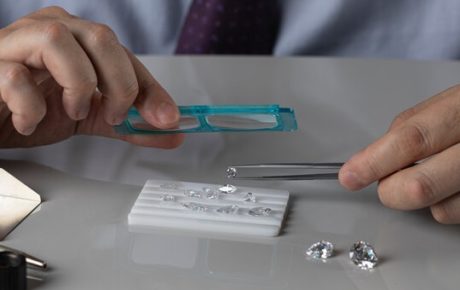
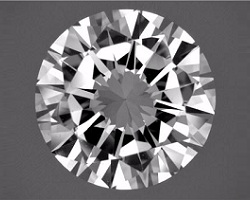
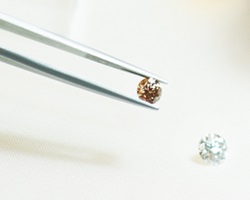









5 Comments
Do the spread diamonds have windowing effect due to the shallow cut? Between princess cuts and cushion cuts, which would have better spread?
And on the other side, what brings lapidarists to cut gems very deep, if the gem appears to be smaller and it gives issues like light leakages and black spots?
It depends on the degree of spread. In essence, the answer would be yes. As diamonds get shallower, the windowing effect becomes more pronounced.
When comparing cushion cuts to princess cuts, I would say that cushion shapes tend to face up larger than princess shapes because princess tends to have deeper depths due to the nature of their cutting styles. Within cushion cuts, the spread can vary as there are elongated cushion cut outlines and squarish outlines.
Profits are the main reason why lapidarists cut gems for weight retention because that’s what the general market values most at the moment.
My fiancee and I were gifted a heirloom diamond for us to create our engagement ring. We brought it to an appraisal for a check recently and it was estimated to have a carat weight of 0.90ct. However, when I compared the diamond size to my friend’s 1.00 ct diamond, they were both similar in size. The appraiser told me that it is a shallow diamond with very high spread. Because of the low crown angles and thin girdle it had, it can be susceptible to chipping and only has a Good cut rating.
Hearing this, I’m not so sure whether I want this shallow cut diamond in my engagement ring which I plan to wear forever. The appraiser also mentioned that if I like how it looked like, then it is all that matters. I am having second thoughts and this is a sensitive issue as my boyfriend is a sentimental person. What would you advice I do?
With shallow cut diamonds that have excessive spread, I can tell you that these diamonds lack sparkle and life because of proportioning issues. In your case, an extremely low crown angle creates a higher risk of chipping during the setting process and also because of knocks. That’s because the girdle thickness is too thin and has insufficient mechanical strength. Personally, I would never buy or use a shallow cut diamond in an engagement ring and that’s objective advice. In your case, there’s alot of other subjective factors that come into play. Deciding to use the spready diamond or not is something you need to figure out yourself. I think you need to communicate and work things out with your boyfriend together.
Thank you for the valuable information about shallow diamonds. I have a shallow pear cut diamond engagement ring that I bought for a modest price. The clarity and color are excellent. I cannot see any inclusion and is colorless. Following your advice, I think I will take the head of the diamond ring and convert it to a pendant since the spread makes it thin and may chip. For the dilemma about the person with the engagement solitare diamond, I suggest making a pendant with it and buying a new diamond for your engagement ring.